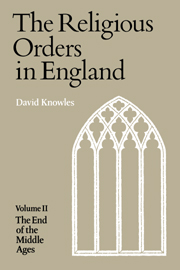Book contents
- Frontmatter
- Contents
- Preface
- List of Abbreviations
- Part One The Historical Framework
- Part Two The Institutional Background
- Chap. XVII Recruitment, employment and the horarium
- Chap. XVIII The wage-system and the common life
- Chap. XIX The election and privileges of the superior
- Chap. XX The numbers of the religious
- Chap. XXI Literary work
- Chap. XXII The monasteries and society
- Chap. XXIII Vicarages, the cure of souls and schools
- Chap. XXIV Public obligations of heads of houses
- Chap. XXV The monastic economy, 1320–1480
- Chap. XXVI Monastic Libraries
- Chap. XXVII Retrospect
- Appendix I Chaucer's monk
- Appendix II Henry V and the Westminster recluse
- Appendix III Regulars as bishops
- Bibliography
- Index
Chap. XXV - The monastic economy, 1320–1480
Published online by Cambridge University Press: 28 January 2010
- Frontmatter
- Contents
- Preface
- List of Abbreviations
- Part One The Historical Framework
- Part Two The Institutional Background
- Chap. XVII Recruitment, employment and the horarium
- Chap. XVIII The wage-system and the common life
- Chap. XIX The election and privileges of the superior
- Chap. XX The numbers of the religious
- Chap. XXI Literary work
- Chap. XXII The monasteries and society
- Chap. XXIII Vicarages, the cure of souls and schools
- Chap. XXIV Public obligations of heads of houses
- Chap. XXV The monastic economy, 1320–1480
- Chap. XXVI Monastic Libraries
- Chap. XXVII Retrospect
- Appendix I Chaucer's monk
- Appendix II Henry V and the Westminster recluse
- Appendix III Regulars as bishops
- Bibliography
- Index
Summary
In considering the exploitation of estates and the administering of funds attention will be confined to the monastic and canonical orders which came into being before 1200. These were all, to a greater or less degree, possessed of land and other sources of wealth and thus, in the term current in the controversies of the fourteenth century, were the ‘possessioners’, as opposed to the various orders of friars who were, in principle and to a large degree in fact also, possessionless and mendicant. Within the class of the possessioners a further division may be made between the old orders—the black monks and canons—and the new—the white monks and canons, together with the Gilbertines, the Grandmontines and the Carthusians. The old orders will be treated here, and attention will be given principally to the black monks, if only because their estates were in so many cases large, wealthy and widely scattered, whereas the canons' houses, with a few notable exceptions, had estates of moderate size which, in the vast majority of cases, lay around or near the abbey or priory. It may be added that through accident of survival the original documents are most plentiful for a small group of large black monk houses, and that through accident of accessibility, the printing and interpreting of these documents has hitherto been all but confined to the small but important class of cathedral priories.
In all these houses the administration was carried on within the framework of what has been called the ‘obedientiary system’.
- Type
- Chapter
- Information
- Religious Orders Vol 2 , pp. 309 - 330Publisher: Cambridge University PressPrint publication year: 1979



